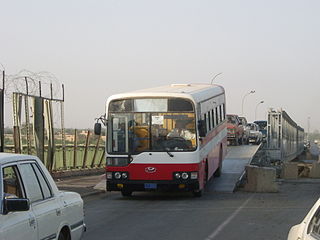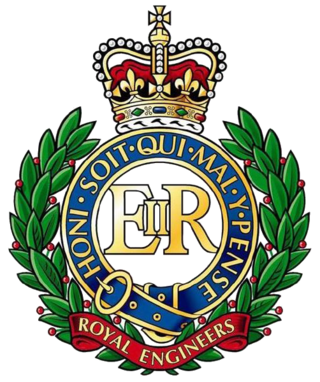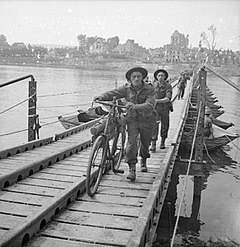
A military engineering vehicle is a vehicle built for construction work or for the transportation of combat engineers on the battlefield. These vehicles may be modified civilian equipment or purpose-built military vehicles. The first appearance of such vehicles coincided with the appearance of the first tanks, these vehicles were modified Mark V tanks for bridging and mine clearance. Modern military engineering vehicles are expected to fulfill numerous roles, as such they undertake numerous forms, examples of roles include; bulldozers, cranes, graders, excavators, dump trucks, breaching vehicles, bridging vehicles, military ferries, amphibious crossing vehicles, and combat engineer section carriers.

A pontoon bridge, also known as a floating bridge, uses floats or shallow-draft boats to support a continuous deck for pedestrian and vehicle travel. The buoyancy of the supports limits the maximum load that they can carry.

The Balao class was a successful design of United States Navy submarine used during World War II, and with 120 boats completed, the largest class of submarines in the United States Navy. An improvement on the earlier Gato class, the boats had slight internal differences. The most significant improvement was the use of thicker, higher yield strength steel in the pressure hull skins and frames, which increased their test depth to 400 feet (120 m). Tang actually achieved a depth of 612 ft (187 m) during a test dive, and exceeded that test depth when taking on water in the forward torpedo room while evading a destroyer.

Landing craft are small and medium seagoing watercraft, such as boats and barges, used to convey a landing force from the sea to the shore during an amphibious assault. The term excludes landing ships, which are larger. Production of landing craft peaked during World War II, with a significant number of different designs produced in large quantities by the United Kingdom and United States.

Landing Ship, Tank (LST), or tank landing ship, is the naval designation for ships first developed during World War II (1939–1945) to support amphibious operations by carrying tanks, vehicles, cargo, and landing troops directly onto shore with no docks or piers. This enabled amphibious assaults on almost any beach.

A Landing Craft Utility (LCU) is a type of boat used by amphibious forces to transport equipment and troops to the shore. They are capable of transporting tracked or wheeled vehicles and troops from amphibious assault ships to beachheads or piers.

Armoured Vehicle Royal Engineers (AVRE), also known as Assault Vehicle Royal Engineers is the title given to a series of armoured military engineering vehicles operated by the Royal Engineers (RE) for the purpose of protecting engineers during frontline battlefield operations.

The Mabey Logistic Support Bridge is a portable pre-fabricated truss bridge, designed for use by military engineering units to upgrade routes for heavier traffic, replace civilian bridges damaged by enemy action or floods etc., replace assault and general support bridges and to provide a long span floating bridge capability. The bridge is a variant of the Mabey Compact 200 bridge, with alterations made to suit the military user as well as a ramp system to provide ground clearance to civilian and military vehicles.

A pontoon boat is a flattish boat that relies on floats to remain buoyant. These pontoons contain much reserve buoyancy and allow designers to create large deck plans fitted with a variety of accommodations including expansive lounge areas, stand-up bars, and sun pads. Better tube designs have allowed builders to put ever-increasing amounts of horsepower on the stern. Pontoon boat drafts may be as shallow as eight inches, which reduces risk of running aground and underwater damage, this allows it to come close to shore to pick up and drop off loads.

USS LST-16 was a LST-1-class tank landing ship built for the U.S. Navy during World War II. Like most ships in her class, she was not named and was known only by her designation. She was staffed by a U.S. Coast Guard crew throughout her service career.

An amphibious warfare ship is an amphibious vehicle warship employed to land and support ground forces, such as marines, on enemy territory during an amphibious assault.

Floats are airtight hollow structures, similar to pressure vessels, designed to provide buoyancy in water. Their principal applications are in watercraft hulls, aircraft floats, floating pier, pontoon rhinos, pontoon causeways, and marine engineering applications such as salvage.

The PMP Floating Bridge is a type of mobile pontoon bridge designed by the Soviet Union after World War II. The bridge's design enables for a quick assembly of its parts. It has a carrying capacity of 60 tons. The bridge was originally mounted on a KrAZ-214, but later transferred to a KrAZ-255. During the process of its deployment, a truck carrying the bridge is backed alongside the edge of a body of water. The bridge is then rolled off where it unfolds automatically. The bridge spans 382 metres, load capacity 20 tons, or 227 m, load capacity 60 tons, with 32 river pontoons, 12 bridging boats and four shore pontoons.
HMS Misoa was a Maracaibo-class LST Mk.I tank landing ship of the British Royal Navy during World War II. A converted Lake Maracaibo oil tanker, she took part in the invasions of North Africa, Sicily, and Normandy.

This is a list of bridging and trackway equipment used by the Royal Engineers of the British Army. For more equipment in use with the Royal Engineers, see Modern equipment of the British Army.

The 549th Engineers Light Pontoon Company was a combat engineer company of the United States Army during World War II. Operationally attached to the 1150th Engineer Combat Group, it served under XXI Corps of the Seventh Army in action in France and Germany in 1944 and 1945.

An Engineer Light Ponton Company was a combat engineer company of the United States Army that served with U.S. Army ground forces during World War II. It was primarily a highly mobile pontoon bridge construction unit, though it also provided both M2 assault boats and a selection of infantry support bridging, ferries, and rafts.

British logistics supported the operations of the Anglo-Canadian 21st Army Group in the Western Allied invasion of Germany from 8 January 1945 until the end of the Second World War in Europe on 8 May 1945. To conserve scarce manpower, the British and Canadian forces employed mechanisation and materiel to maximum effect. This involved prodigious use of ammunition, fuel and equipment, which in turn demanded a first-class military logistics system. By this time, the British Army was highly experienced, professional and proficient.




















